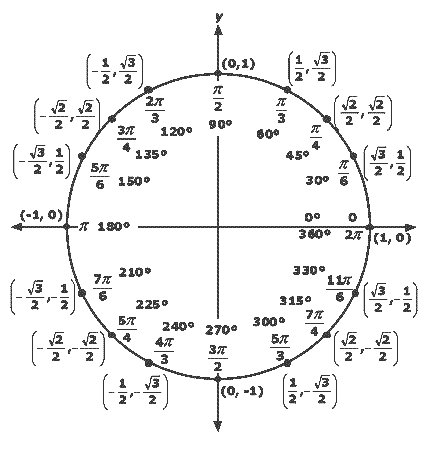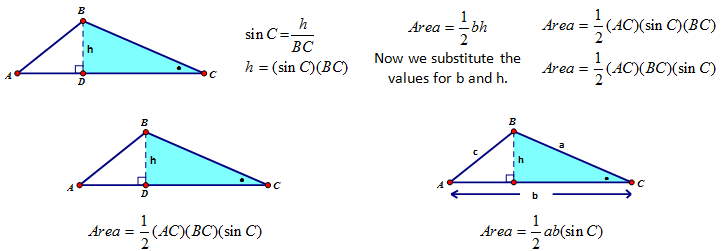Inquiry Activity Summary
 |
| http://31.media.tumblr.com/tumblr_kueutly2bF1qa3sx1o1_500.gif |
1.First off, i was given a 30' triangle and asked to follow certain steps. First, I had to label according to the rules of special right triangles. I had a 30' acute angle which then a 60' and 90' came to add up to 180'. The hypotenuse was 2x, and then the 30' side was xrad3 and the y side was x. The next step told us to simplify all sides so that the hypotenuse was equal to 1. You divide every side by 2x and you get 1,rad3/2, and 1/2. The next steps told us to label the hypotenuse r, the horizontal side x and the vertical side y. I then drew a coordinate plane so that the triangle laid in the first quadrant of the unit circle. I had to label the vertices of the triangle as ordered pairs. They were (0,0), (rad3/2,0), and (rad3/2 ,1/2).

2. Next, we moved on to the 45' 45' 90' triangle which is isosceles. We had to label again according to the rules of special right triangles. We had to simplify all sides so that r was 1. In this case the hypotenuse was xrad2 so we had to divide by xrad2. The x side was x so we divided by xrad 2 and got rad2/2 after we rationalized it. and the y side x also so we got rad2/2 after being rationalized. After we labeled the hypotenuse r and the horizontal side x and vertical side y. Then we drew a coordinate plane so that this triangle was in the first quadrant of the unit circle. Finally we labeled all three vertices of each triangle as ordered pair. They were (0,0), (rad2/2 , 0) , and (rad2/2, rad2/2).

3. Finally, we had to label a 60' triangle. We identified it with the rules of special right triangle. The other side is 30 and we have a 90 degree right triangle. Next we had to simplify the sides so that the hypotenuse was 1. The hypotenuse was 2x to begin with so in order to simplify it to 1 we had to divide by 2x. The horizontal side was x so when I divided it by 2x i got 1/2. The vertical side was xrad3 so dividing it by 2x left me with rad3/2.I then labeled the hypotenuse r and the horizontal side x and vertical side y. I drew a coordinate plane so that the triangle was in quadrant one of the unit circle. Finally i labeled all three vertices of the triangle as ordered pair. They were (0,0) , (1/2, 0) , (1/2 , rad3/2).

4.This activity helped me derive the unit circle because these three triangles lie in the first quadrant of the unit circle. I had known about the unit circle and the values ( rad3/2 , 1/2) (rad2/2 , rad2/2), and (1/2, rad3/2) were taught to me and i was given no reason for why or how they came about. I was simply told to memorize these values. This activity explained to me and showed me where these values came from. Step two was the part that did the most explaining because simplifying the values showed me where the r , x and y, values came from. Step 6 illustrated to me where these values and triangles fit in the unit circle. Knowing how these values are brought about and how they fit into the first quadrant of the unit circle helped me find reference angles and other values on the other quadrants of the unit circle. Knowing the first quadrant helped me fill out the rest of the unit circle without much work. Simply memorizing and knowing the first quadrant allowed me to fill out and understand the following concepts of this unit as well as future and past concepts. This activity was more like the glue of this unit, it brought everything together.
5.The triangles in this activity lie in quadrant one. Since all the signs are positive because it lies in the first quadrants, all the ordered pairs are positive as well. Remember that All Students Take Calculus!!! As we move into the second quadrant, the only the values that are positive are sine and cosecant values, so all the X values of each ordered pair is negative. The 30 reference angle is 150. The 60 reference angle is 120. The 45 degree reference angle is 135.As we move into the third quadrant, the only values that are positive are tangent and cotangent so both values of each ordered pair are negative. The 60 reference angle is 240. The 45 reference angle is 225. The 30 reference angle is 210.The last quadrant the only values that are positive are cosine and secant so the Y of each ordered pair is negative. The 30 reference angle is 330. The 45 reference angle is 315. The 60 reference angle is 300. Their ordered pairs stay the same however the signs of certain values change as we move around the unit circle. As the 60 degree traingle moves around the unit circel you can see the location of the 1 and rad3/2 and 1/2 change as it moves around. The angles also get bigger. The same can be said for the 45 degree trainlge and the 30 degree traingle their r,x, and y values all change locations as it moves around but you can see they are used ass the refernce angles for all around the angle. Knowing these angles helps label them all around. In essance the whole unit circel is 4 30 degree trainlges, 4 60 degree traingles, and 4 30 degree traingles but just flipped around as it goes around.
 |
60 degree traingle
https://blogger.googleusercontent.com/img/proxy/AVvXsEg3l4inVZ2EA6LAuMtER4DPqHRdCxYPCuA2wEoM3f185eKvMawkwg-1V9V7-XVTUIUHua2i5Fw5U0jppuCmhm8TYrFkXILc1SZDaDWFQ_NLtNgVyQ0vaQxf1viwRrvJcjGnqLHrbzEcpiZMkpf7XPbu9SpeUZaWW80VeagxihtbpZfTPfJE3iwUu_-reG2D4dS7CIObgBkotEoL=
=blogger&gadget=a&rewriteMime=image%2F* |
 |
60 degree traingles
https://blogger.googleusercontent.com/img/proxy/AVvXsEj6I1JOq4IgpoPFhz57-9nyXOU65aUiAgxvEdSwkP_vDWBUksFc0hs9-wb7lyz53gjovCKxdXRP-boO9FWREf9_AGe041kW2cRSfHYZW8EXyMB9FJ6uKM-kwp93ygFP59HGmYKeC8yFj3DPgpORWxUxsccjqAmK5vfgbhVE0HIrkQy1UXN-dCqK4KNyvhLztTGcbCsvZBWQETGJ=
&gadget=a&rewriteMime=image%2F* |
 |
30 degree traingles
http://01.edu-cdn.com/files/static/learningexpressllc/9781576855966/The_Unit_Circle_34.gif |
 |
45 degree traingle
http://01.edu-cdn.com/files/static/learningexpressllc/9781576855966/The_Unit_Circle_45.gif |
 |
45 degree traingles
http://02.edu-cdn.com/files/static/learningexpressllc/9781576855966/The_Unit_Circle_46.gif |
THE COOLEST THING I LEARNED FROM THE ACTIVITY WAS that the unit circle actually derived from something.Last year we were just told what the values were , given them, and told to memorize the unit circle under 5 minutes without further explanation as to why we needed to know it or what it helped us in math.
THIS ACTIVITY WILL HELP ME IN THIS UNIT because once I know the first quadrant and the angles and what comes with them, then the units and points, etc, will come easily. For example, knowing reference angles and co-terminal angles help with future and past concepts.
SOMETHING I NEVER REALIZED ABOUT SPECIAL RIGHT TRIANGLES AND THE UNIT CIRCLE is that everything I have done with the triangles in the my high school years has finally all come together and made sans. All I learned was for a reason and simply not to memorize useless material.Once I knew the unit circle, the rest of the unit circle came easy. A ll i needed to know was in the first quadrant and then this and future concepts correlated with this.
YAY FOR MRS. KIRCH AND HER EXPLANATIONS OF THE UNIT CIRCLE!!!!:)
Sources:
http://31.media.tumblr.com/tumblr_kueutly2bF1qa3sx1o1_500.gif
http://02.edu-cdn.com/files/static/learningexpressllc/9781576855966/The_Unit_Circle_46.gif
http://01.edu-cdn.com/files/static/learningexpressllc/9781576855966/The_Unit_Circle_45.gif
http://01.edu-cdn.com/files/static/learningexpressllc/9781576855966/The_Unit_Circle_34.gif
https://blogger.googleusercontent.com/img/proxy/AVvXsEj6I1JOq4IgpoPFhz57-9nyXOU65aUiAgxvEdSwkP_vDWBUksFc0hs9-wb7lyz53gjovCKxdXRP-boO9FWREf9_AGe041kW2cRSfHYZW8EXyMB9FJ6uKM-kwp93ygFP59HGmYKeC8yFj3DPgpORWxUxsccjqAmK5vfgbhVE0HIrkQy1UXN-dCqK4KNyvhLztTGcbCsvZBWQETGJ=
&gadget=a&rewriteMime=image%2F*
https://blogger.googleusercontent.com/img/proxy/AVvXsEg3l4inVZ2EA6LAuMtER4DPqHRdCxYPCuA2wEoM3f185eKvMawkwg-1V9V7-XVTUIUHua2i5Fw5U0jppuCmhm8TYrFkXILc1SZDaDWFQ_NLtNgVyQ0vaQxf1viwRrvJcjGnqLHrbzEcpiZMkpf7XPbu9SpeUZaWW80VeagxihtbpZfTPfJE3iwUu_-reG2D4dS7CIObgBkotEoL=
=blogger&gadget=a&rewriteMime=image%2F*







.png)
.png)





























